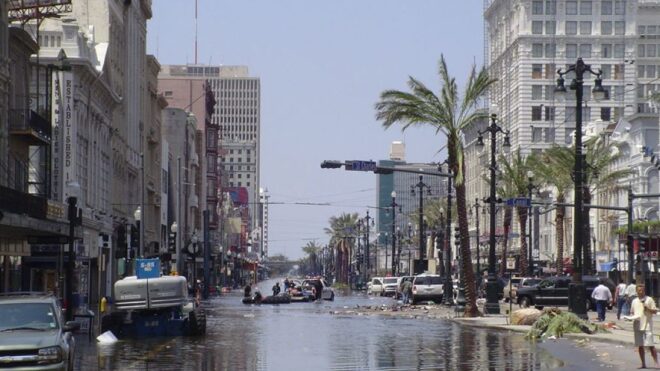Pascal Architects is no stranger to Hurricanes. In our 30 year history, there have been a few notable storms including Katrina and more recently, Hurricane Ida. You may be asking why an architecture firm is concerned with disaster relief, but we’re here to explain why having an experienced architect on your disaster relief team is critical to not only the structural integrity of your building, but also the successful mediation with insurance companies.
When Hurricane Ida made landfall in the greater New Orleans area on August 29, 2021, the 16th anniversary of Hurricane Katrina, we had a relief plan in place days before so that we could spring into action. Here’s what the process typically looks like:
Staging Before The Storm
Before a rain drop even touches land, the Pascal Architects team is closely watching the weather and setting up staging centers with temping materials, diesel generators on flatbeds, air-cooled chillers and dehumidifiers. These are the first materials needed after the storm hits.
Building Stabilization & Water Mitigation
After the storm hits, the first thing we do is stabilize the building. We patch the roof, temp in windows and make every attempt to make the building less susceptible to further moisture entry. Often during this period, there is no power to the building, so our next focus is to get the power back on for our clients and oftentimes, the return of power is at the mercy of the electric companies. So, our team does everything in our control to protect the building from further heat and humidity damage.
We set up air-chilled coolers and dehumidifiers that run off diesel generators on flatbeds in an effort to keep the building cool and dry with load centers on every floor to move air across the dehumidifiers. The second humidity attacks a building, the resulting issues are mold, rot, and soft spots in the building structure that could mean costly damages down the road. This process took about 4 weeks for most of our clients after Hurricane Ida ripped through the city of New Orleans last year.
Assessment of Scope of Damage
After the building is stabilized, we assess the full scope of damage to the building. We go through the building in detail and quickly assess what the client can and can’t keep in the building as drying techniques continue. Our rule of thumb is that if any material is over 25% saturated at this walk through, it needs to be replaced. This process usually takes place up to 8 weeks after the storm hits, depending on the size of the building.
Quantifying the Scope of Work
During the 8 week period post-Hurricane, most of our clients are taking advantage of business interruption insurance. It is our job to quantify the scope of work and work with the property damage insurance carriers as quickly as possible to ensure that the business interruption insurance doesn’t end before repairs are made.
At this time, our teams are typically just restoring normalcy to their personal property as well, but the work begins for them to begin pricing and creating drawings for the repairs to present to the insurance companies.
Mediation with Insurance Companies
We go to bat for our clients because we are often dealing with building materials for historic buildings on the National Register that require specific regulation in order for the building to maintain its status as a historic building. During this phase, we are educating both our client and the insurance company on why we need to use specific materials in the repair process and mediating between what the insurance company wants to pay and what the cost of materials are for repair. This process is the longest and slowest piece of the disaster relief puzzle.
Construction
Finally, we make it to construction after settling on a property insurance claim. It is not uncommon for construction to begin up to a year after the initial storm. Typically, we start with the interior work and work as quickly as we can to get at least part of the building to full operation. Then, we move to the exterior to finish up the project….just in time for another Hurricane season!
The Pascal Architects team is dedicated to helping our clients recover after a natural disaster. We have the experience and tools to help our clients navigate what is often, one of the most stressful times in their business and we consider it an honor to be a part of their team.
To learn more about some of the historic buildings that we restore, visit our portfolio.



